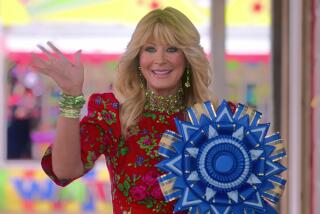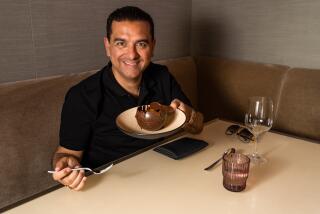Review: ‘Ottolenghi and the Cakes of Versailles’ offers a deeper cut than likely intended
- Share via
Criticism should strive to be evergreen, but criticism and objects of critique can almost never be divorced from their context: the context in which a film was made, and the context in which a film is viewed by a critic. Six months into a global pandemic, the charming documentary “Ottolenghi and the Cakes of Versailles,” about a high-end pastry party at the Metropolitan Museum of Art, startled me with the sense of a frustratingly intangible very recent history. Remember museums? Events? Sharing unfettered indoor space with strangers? Let this documentary take you back to that world, which is so close, yet so far away.
The film is directed by Laura Gabbert, who has carved out a niche for herself in the food-cinema world, having directed the Jonathan Gold documentary “City of Gold” and an episode of “Ugly Delicious” (as well as “Sunset Story” and “No Impact Man”). Her work is about culture, because food is culture, and “Ottolenghi and the Cakes of Versailles” sits at a tantalizing intersection of food, art and history. It’s the story of a remarkable event at the Met that inadvertently becomes shockingly prescient.
The maestro at the center is Yotam Ottolenghi, the London-based Israeli chef and cookbook author, whose tomes of Middle Eastern fusion recipes grace the shelf of most every ambitious home cook. Known for his London shop windows piled high with confections and salads and spices like a king’s table, Ottolenghi is the ideal candidate to produce a Versailles-themed dessert event for the Met. He studies Versailles, and then he studies Instagram, searching for cutting-edge international chefs and artists who are pushing the limits of pastry to produce cakes celebrating the artistic and technical patisserie innovations developed at Versailles. He taps five: Dominique Ansel (of “cronut” fame), Ghaya Oliveira of the New York restaurant Daniel, Singaporean sweets impresario Janice Wong, British Jello mold artists Bompas and Parr, and Ukrainian 3=D cake designer Dinara Kasko.
There is much talk of Versailles as the epicenter of European politics, art, design, fashion, food, culture and trends in the 18th century, thanks , of course, to money, and lots of it. The art produced there was intended to display that wealth and power. This is well articulated by Bard professor Deborah Krohn, who becomes Ottolenghi’s academic guide. For King Louis XVI, decadent, luxurious and rare foods such as fruit and refined sugar were melted, mixed and molded into elaborate confectionery that screamed status. Today, that status goes to the individual chefs who become celebrities on social media. The event, which is more Met Gala than “The Great British Baking Show,” underscores that. This is sugar theater, ready to be gobbled up.
It’s not until the cake plates are cleared that “Ottolenghi and the Cakes of Versailles” directly addresses the elephant in the room, which is where Marie Antoinette and King Louis XVI’s tale ends: at the guillotine. Tremendous inequality led the French to revolt against their 1% who hoarded wealth while the people lacked flour for bread. Manhattan’s shiny skyscrapers loom ominously over this discussion.
Deep into an economic crisis, this notion has a greater impact than Gabbert or the participants could have known at the time. For such a sweet film, “Ottolenghi and the Cakes of Versailles” evolves into a complex exploration of the symbiotic relationship between money and art, and questions what the visibility of that conspicuous consumption could portend.
'Ottolenghi and the Cakes of Versailles'
Not rated
Running time: 1 hour, 15 minutes
Playing: In limited release where theaters are open; also on VOD
More to Read
Only good movies
Get the Indie Focus newsletter, Mark Olsen's weekly guide to the world of cinema.
You may occasionally receive promotional content from the Los Angeles Times.










